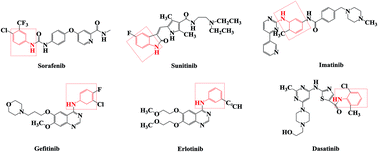Design, synthesis, and bioactivity evaluation of antitumor sorafenib analogues
Abstract
Malignant tumors are a serious threat to human health and are generally treated with chemical therapy. This chemical therapy uses agents that act on signal transduction pathway mechanism of tumor with good selectivity and low toxicity. Sorafenib is a multikinase target inhibitor with good tumor inhibitory activity and a protein kinase inhibitor. In this research, a novel series of sorafenib analogues and derivatives were designed, synthesized, and evaluated as tumor inhibitors. These compounds used sorafenib as the lead compound and achieved modifications using bioisosteres and the alkyl principle. The in vitro the results showed that compounds 3c, 3d, 3h, 3n, 3r, and 3z had good inhibitory effects on human cervical cancer cells (Hela), while compounds 3t and 3v had good inhibitory effects on human lung cancer cells (H1975 and A549). Among these, compound 3d had an inhibitory activity (IC50) of 0.56 ± 0.04 μmol L−1 against Hela cells (human cervical cancer), the compound 3t had an IC50 of 2.34 ± 0.07 μmol L−1 against H1975 cells (human lung cancer), and compound 3v had an IC50 of 1.35 ± 0.03 μmol L−1 against A549 cells (human lung cancer). The in vivo results showed that these compounds had good antitumor effects and low acute toxicity.



 Please wait while we load your content...
Please wait while we load your content...